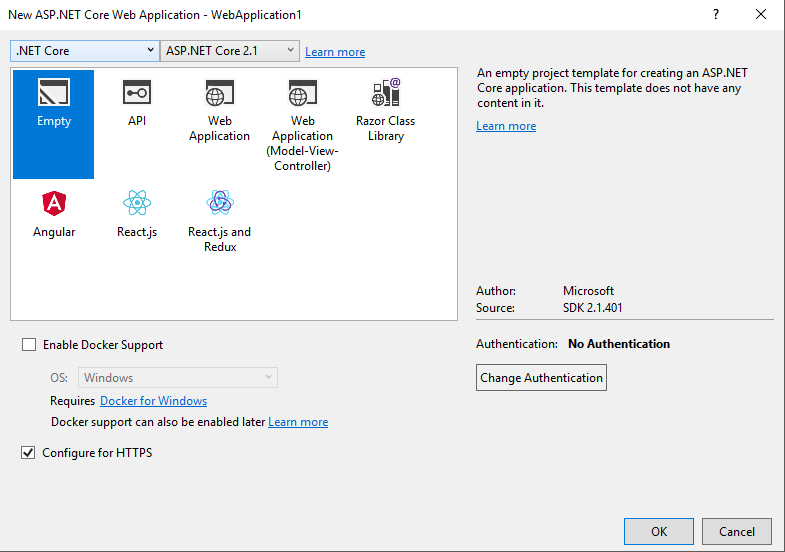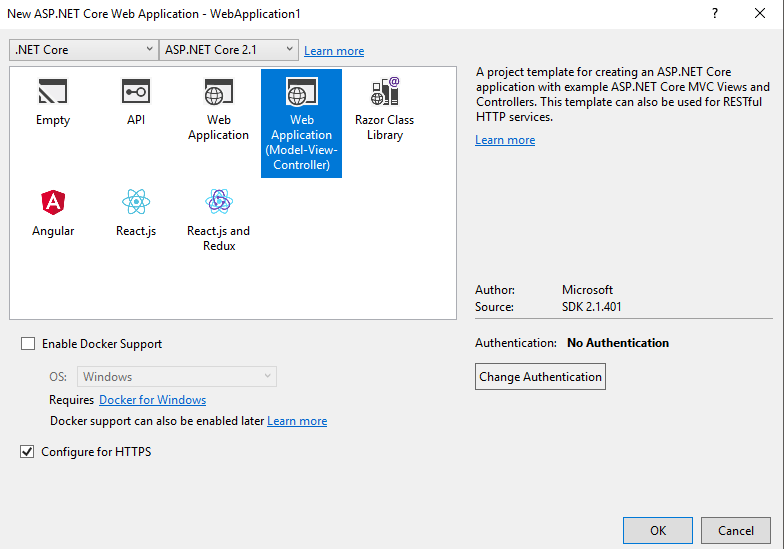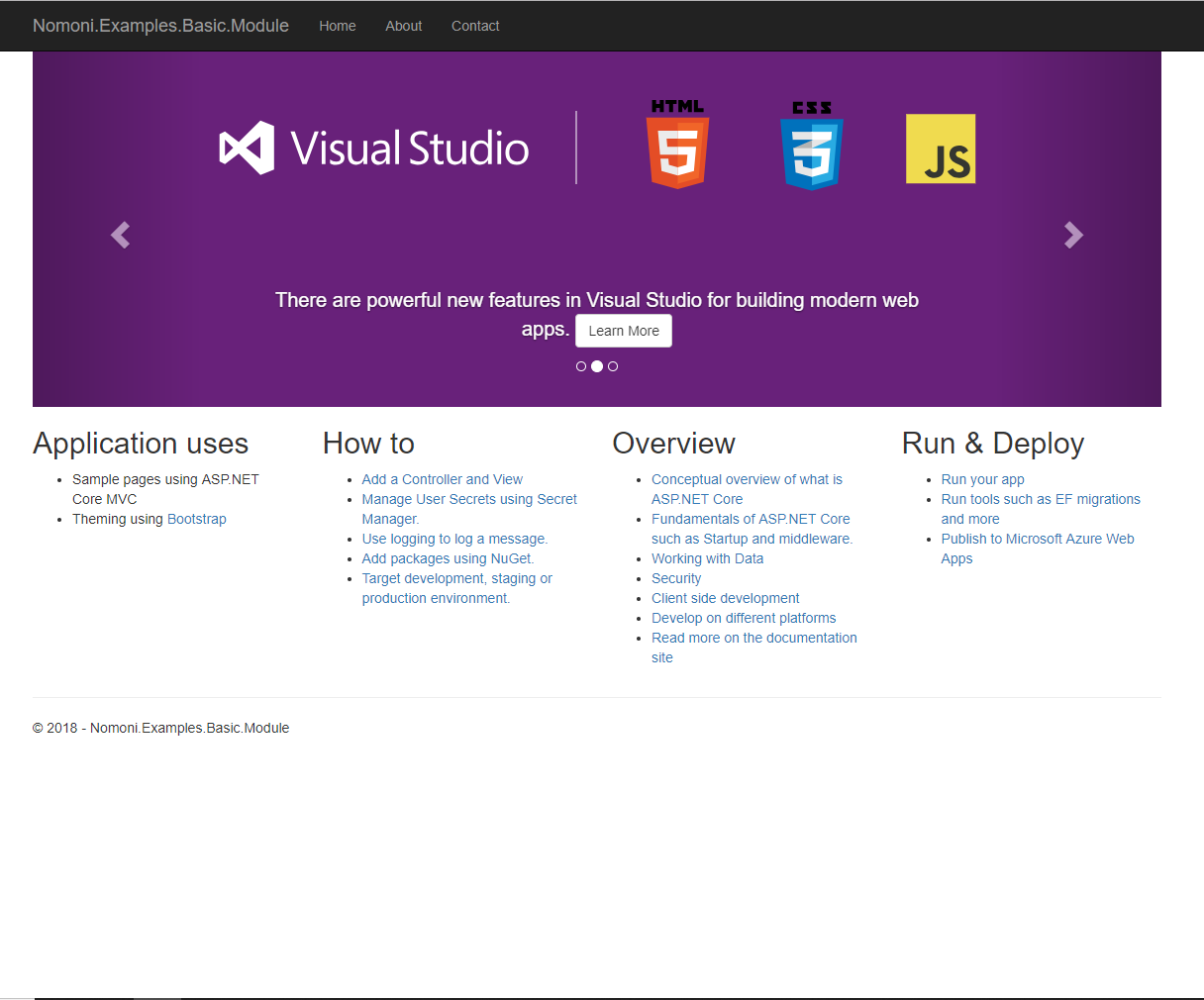Part 1: Basic Web App with single module
Welcome to part one of the getting started tutorials. This tutorial describes the process of creating a basic web app using Nomoni. The final result will be exactly what you would excpect to see from a default .net core web app template.
Step 1 : Create empty .net core web application
This will be the presentation project which all the module projects that will be created later on will be loaded into.
Step 2 : Install Nomoni.MVC nuget package
Install the Nomoni.Mvc package in the empty presentation project
Install-Package Nomoni.Mvc
Step 3 : Update Startup.cs
Update the Startup class in the presentation project so it looks like the following:
public class Startup
{
// This method gets called by the runtime. Use this method to add services to the container.
// For more information on how to configure your application, visit https://go.microsoft.com/fwlink/?LinkID=398940
public void ConfigureServices(IServiceCollection services)
{
services.AddMvc().SetCompatibilityVersion(CompatibilityVersion.Version_2_1);
services.UseNomoni();
}
// This method gets called by the runtime. Use this method to configure the HTTP request pipeline.
public void Configure(IApplicationBuilder app, IHostingEnvironment env)
{
if (env.IsDevelopment())
{
app.UseDeveloperExceptionPage();
}
app.UseNomoni();
app.UseStaticFiles();
}
}
Step 4 : Create your first module project
Add a new .net core MVC web application project. This will form the basis of our first module.
Step 5 : Install Nomoni.Mvc nuget package
Install the Nomoni.Mvc package in the module project
Install-Package Nomoni.Mvc
Step 6 : Remove Unnecessary Things
Delete the following from the module project:
- Startup.cs
- appsettings.json
And amend Project.cs to the following:
public class Program
{
public static void Main(string[] args)
{
}
}
Step 7 : Update Module Project .csproj
Update the module projects .csproj file to look like this:
<Project Sdk="Microsoft.NET.Sdk.Web">
<PropertyGroup>
<TargetFramework>netcoreapp2.1</TargetFramework>
<GenerateEmbeddedFilesManifest>true</GenerateEmbeddedFilesManifest>
</PropertyGroup>
<ItemGroup>
<EmbeddedResource Include="Views\**;wwwroot\**" />
</ItemGroup>
<ItemGroup>
<PackageReference Include="Microsoft.AspNetCore.App" />
<PackageReference Include="Nomoni.Mvc" Version="0.1.18246" />
</ItemGroup>
</Project>
Step 8 : Create Module Definition
Add a new folder to the module project called “Registrations”.
Add a new file called “ModuleInfo.cs” and implement the IModule interface found in Nomoni.Core.Abstractions
public class ModuleInfo : IModule
{
public string Name => "Example Module";
public string Author => "Jon Ryan";
}
Step 9 : Create Route Registration Definition
Add a new file to “Registrations” called “RouteRegistration.cs” and implement the IRouteRegistration interface found in the Nomoni.Mvc.Registration namespace
public class RouteRegistration : IRouteRegistration
{
public int Priority => 1000;
public void Execute(IRouteBuilder routeBuilder)
{
routeBuilder.MapRoute(name: "module", template: "{controller}/{action}/{id?}", defaults: new { controller = "Home", action = "Index" });
}
}
Step 10 : Launch App
In the presentation project add the module project as a reference. Then build and run.
If the steps were successful then you should have a classic ASP .net Core App running
Source code for this example
The source code for this tutorial can be found here:
https://github.com/treefishuk/nomoni/tree/master/examples/Nomoni.Examples.Basic
Next Steps
In Part 2 : Adding a second module we will add a second module to the solution.


